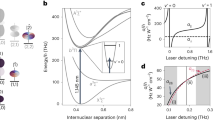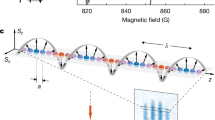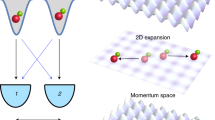Abstract
Synthetic quantum systems with interacting constituents play an important role in quantum information processing and in explaining fundamental phenomena in many-body physics. Following impressive advances in cooling and trapping techniques, ensembles of ultracold polar molecules have emerged as a promising platform that combines several advantageous properties1,2,3,4,5,6,7,8,9,10,11. These include a large set of internal states with long coherence times12,13,14,15,16,17 and long-range, anisotropic interactions. These features could enable the exploration of intriguing phases of correlated quantum matter, such as topological superfluids18, quantum spin liquids19, fractional Chern insulators20 and quantum magnets21,22. Probing correlations in these phases is crucial to understanding their properties, necessitating the development of new experimental techniques. Here we use quantum gas microscopy23 to measure the site-resolved dynamics of quantum correlations of polar 23Na87Rb molecules confined in a two-dimensional optical lattice. By using two rotational states of the molecules, we realize a spin-1/2 system with dipolar interactions between particles, producing a quantum spin-exchange model21,22,24,25. We study the evolution of correlations during the thermalization process of an out-of-equilibrium spin system for both spatially isotropic and anisotropic interactions. Furthermore, we examine the correlation dynamics of a spin-anisotropic Heisenberg model engineered from the native spin-exchange model by using periodic microwave pulses26,27,28. These experiments push the frontier of probing and controlling interacting systems of ultracold molecules, with prospects for exploring new regimes of quantum matter and characterizing entangled states that are useful for quantum computation29,30 and metrology31.
This is a preview of subscription content, access via your institution
Access options
Access Nature and 54 other Nature Portfolio journals
Get Nature+, our best-value online-access subscription
$29.99 / 30 days
cancel any time
Subscribe to this journal
Receive 51 print issues and online access
$199.00 per year
only $3.90 per issue
Buy this article
- Purchase on Springer Link
- Instant access to full article PDF
Prices may be subject to local taxes which are calculated during checkout





Similar content being viewed by others
Data availability
Source data can be found in the Harvard Dataverse58. All other supporting data are available from the corresponding author upon reasonable request.
Code availability
The code used in this manuscript is available from the corresponding author upon reasonable request.
References
Ni, K.-K. et al. A high phase-space-density gas of polar molecules. Science 322, 231–235 (2008).
Barry, J., McCarron, D., Norrgard, E., Steinecker, M. & DeMille, D. Magneto-optical trapping of a diatomic molecule. Nature 512, 286–289 (2014).
De Marco, L. et al. A degenerate Fermi gas of polar molecules. Science 363, 853–856 (2019).
Anderegg, L. et al. An optical tweezer array of ultracold molecules. Science 365, 1156–1158 (2019).
Cairncross, W. B. et al. Assembly of a rovibrational ground state molecule in an optical tweezer. Phys. Rev. Lett. 126, 123402 (2021).
Son, H., Park, J. J., Ketterle, W. & Jamison, A. O. Collisional cooling of ultracold molecules. Nature 580, 197–200 (2020).
Schindewolf, A. et al. Evaporation of microwave-shielded polar molecules to quantum degeneracy. Nature 607, 677–681 (2022).
Vilas, N. B. et al. Magneto-optical trapping and sub-Doppler cooling of a polyatomic molecule. Nature 606, 70–74 (2022).
Bohn, J. L., Rey, A. M. & Ye, J. Cold molecules: progress in quantum engineering of chemistry and quantum matter. Science 357, 1002–1010 (2017).
Gadway, B. & Yan, B. Strongly interacting ultracold polar molecules. J. Phys. B 49, 152002 (2016).
Moses, S. A., Covey, J. P., Miecnikowski, M. T., Jin, D. S. & Ye, J. New frontiers for quantum gases of polar molecules. Nat. Phys. 13, 13–20 (2017).
Park, J. W., Yan, Z. Z., Loh, H., Will, S. A. & Zwierlein, M. W. Second-scale nuclear spin coherence time of ultracold 23Na40K molecules. Science 357, 372–375 (2017).
Seeßelberg, F. et al. Extending rotational coherence of interacting polar molecules in a spin-decoupled magic trap. Phys. Rev. Lett. 121, 253401 (2018).
Caldwell, L. et al. Long rotational coherence times of molecules in a magnetic trap. Phys. Rev. Lett. 124, 063001 (2020).
Blackmore, J., Gregory, P., Bromley, S., Hutson, J. & Cornish, S. Robust storage qubits in ultracold polar molecules. Nat. Phys. 17, 1149–1153 (2021).
Burchesky, S. et al. Rotational coherence times of polar molecules in optical tweezers. Phys. Rev. Lett. 127, 123202 (2021).
Lin, J., He, J., Jin, M., Chen, G. & Wang, D. Seconds-scale coherence on nuclear spin transitions of ultracold polar molecules in 3D optical lattices. Phys. Rev. Lett. 128, 223201 (2022).
Cooper, N. R. & Shlyapnikov, G. V. Stable topological superfluid phase of ultracold polar fermionic molecules. Phys. Rev. Lett. 103, 155302 (2009).
Yao, N. Y., Zaletel, M. P., Stamper-Kurn, D. M. & Vishwanath, A. A quantum dipolar spin liquid. Nat. Phys. 14, 405–410 (2018).
Yao, N. Y. et al. Realizing fractional Chern insulators in dipolar spin systems. Phys. Rev. Lett. 110, 185302 (2013).
Hazzard, K. R. A., Manmana, S. R., Foss-Feig, M. & Rey, A. M. Far-from-equilibrium quantum magnetism with ultracold polar molecules. Phys. Rev. Lett. 110, 075301 (2013).
Gorshkov, A. V. et al. Tunable superfluidity and quantum magnetism with ultracold polar molecules. Phys. Rev. Lett. 107, 115301 (2011).
Gross, C. & Bakr, W. S. Quantum gas microscopy for single atom and spin detection. Nat. Phys. 17, 1316–1323 (2021).
Barnett, R., Petrov, D., Lukin, M. & Demler, E. Quantum magnetism with multicomponent dipolar molecules in an optical lattice. Phys. Rev. Lett. 96, 190401 (2006).
Yan, B. et al. Observation of dipolar spin-exchange interactions with lattice-confined polar molecules. Nature 501, 521–525 (2013).
Choi, J. et al. Robust dynamic Hamiltonian engineering of many-body spin systems. Phys. Rev. X 10, 031002 (2020).
Geier, S. et al. Floquet Hamiltonian engineering of an isolated many-body spin system. Science 374, 1149–1152 (2021).
Scholl, P. et al. Microwave engineering of programmable XXZ Hamiltonians in arrays of Rydberg atoms. PRX Quantum 3, 020303 (2022).
DeMille, D. Quantum computation with trapped polar molecules. Phys. Rev. Lett. 88, 067901 (2002).
Ni, K.-K., Rosenband, T. & Grimes, D. D. Dipolar exchange quantum logic gate with polar molecules. Chem. Sci. 9, 6830–6838 (2018).
Perlin, M. A., Qu, C. & Rey, A. M. Spin squeezing with short-range spin-exchange interactions. Phys. Rev. Lett. 125, 223401 (2020).
Baranov, M. A., Dalmonte, M., Pupillo, G. & Zoller, P. Condensed matter theory of dipolar quantum gases. Chem. Rev. 112, 5012–5061 (2012).
Defenu, N. et al. Long-range interacting quantum systems. Preprint at https://arxiv.org/abs/2109.01063 (2021).
Browaeys, A. & Lahaye, T. Many-body physics with individually controlled Rydberg atoms. Nat. Phys. 16, 132–142 (2020).
Chomaz, L. et al. Dipolar physics: a review of experiments with magnetic quantum gases. Preprint at https://arxiv.org/abs/2201.02672 (2022).
de Paz, A. et al. Nonequilibrium quantum magnetism in a dipolar lattice gas. Phys. Rev. Lett. 111, 185305 (2013).
de Léséleuc, S. et al. Observation of a symmetry-protected topological phase of interacting bosons with Rydberg atoms. Science 365, 775–780 (2019).
Baier, S. et al. Extended Bose-Hubbard models with ultracold magnetic atoms. Science 352, 201–205 (2016).
Kaufman, A. M. & Ni, K.-K. Quantum science with optical tweezer arrays of ultracold atoms and molecules. Nat. Phys. 17, 1324–1333 (2021).
Rosenberg, J. S., Christakis, L., Guardado-Sanchez, E., Yan, Z. Z. & Bakr, W. S. Observation of the Hanbury Brown-Twiss effect with ultracold molecules. Nat. Phys. 18, 1062–1066 (2022).
Tobias, W. G. et al. Reactions between layer-resolved molecules mediated by dipolar spin exchange. Science 375, 1299–1303 (2022).
Guo, M. et al. Creation of an ultracold gas of ground-state dipolar 23Na87Rb molecules. Phys. Rev. Lett. 116, 205303 (2016).
Reichsöllner, L., Schindewolf, A., Takekoshi, T., Grimm, R. & Nägerl, H.-C. Quantum engineering of a low-entropy gas of heteronuclear bosonic molecules in an optical lattice. Phys. Rev. Lett. 118, 073201 (2017).
Moses, S. A. et al. Creation of a low-entropy quantum gas of polar molecules in an optical lattice. Science 350, 659–662 (2015).
Kwasigroch, M. & Cooper, N. Bose-Einstein condensation and many-body localization of rotational excitations of polar molecules following a microwave pulse. Phys. Rev. A 90, 021605 (2014).
Zeiher, J. et al. Many-body interferometry of a Rydberg-dressed spin lattice. Nat. Phys. 12, 1095–1099 (2016).
Jepsen, P. N. et al. Spin transport in a tunable Heisenberg model realized with ultracold atoms. Nature 588, 403–407 (2020).
Büchler, H. P. et al. Strongly correlated 2D quantum phases with cold polar molecules: controlling the shape of the interaction potential. Phys. Rev. Lett. 98, 060404 (2007).
Capogrosso-Sansone, B., Trefzger, C., Lewenstein, M., Zoller, P. & Pupillo, G. Quantum phases of cold polar molecules in 2D optical lattices. Phys. Rev. Lett. 104, 125301 (2010).
Koepsell, J. et al. Robust bilayer charge pumping for spin- and density-resolved quantum gas microscopy. Phys. Rev. Lett. 125, 010403 (2020).
Yan, Z. Z. et al. Two-dimensional programmable tweezer arrays of fermions. Phys. Rev. Lett. 129, 123201 (2022).
Kotochigova, S. & DeMille, D. Electric-field-dependent dynamic polarizability and state-insensitive conditions for optical trapping of diatomic polar molecules. Phys. Rev. A 82, 063421 (2010).
Neyenhuis, B. et al. Anisotropic polarizability of ultracold polar 40K87Rb molecules. Phys. Rev. Lett. 109, 230403 (2012).
Lin, J., He, J., Ye, X. & Wang, D. Anisotropic polarizability of ultracold ground-state 23Na87Rb molecules. Phys. Rev. A 103, 023332 (2021).
Blackmore, J. A. et al. Ultracold molecules for quantum simulation: rotational coherences in CaF and RbCs. Quantum Sci. Technol. 4, 014010 (2018).
Guo, M., Ye, X., He, J., Quéméner, G. & Wang, D. High-resolution internal state control of ultracold 23Na87Rb molecules. Phys. Rev. A 97, 020501 (2018).
Vexiau, R. et al. Dynamic dipole polarizabilities of heteronuclear alkali dimers: optical response, trapping and control of ultracold molecules. Int. Rev. Phys. Chem. 36, 709–750 (2017).
Christakis, L. et al. Replication Data for: Probing Site-Resolved Correlations in a Spin System of Ultracold Molecules (Harvard Dataverse, 2022); https://doi.org/10.7910/DVN/3WMCXJ.
Acknowledgements
We thank E. Guardado-Sanchez and G. Zheng for experimental assistance. This work was supported by the NSF (grant no. 1912154) and the David and Lucile Packard Foundation (grant no. 2016-65128). L.C. was supported by the NSF Graduate Research Fellowship Program. D.A.H. and A.M. were supported in part by the NSF QLCI grant no. OMA-2120757.
Author information
Authors and Affiliations
Contributions
W.S.B. and D.A.H. conceived the study and supervised the experiment. L.C., J.S.R., R.R. and Z.Z.Y. performed the experiments and the data analysis. A.M. and S.C. performed the numerical calculations. All authors contributed to the manuscript.
Corresponding author
Ethics declarations
Competing interests
The authors declare no competing interests.
Peer review
Peer review information
Nature thanks the anonymous reviewers for their contribution to the peer review of this work.
Additional information
Publisher’s note Springer Nature remains neutral with regard to jurisdictional claims in published maps and institutional affiliations.
Extended data figures and tables
Extended Data Fig. 1 Microwave spectroscopy.
a, Molecular rotational and hyperfine spectrum measured at 60 G. Green, blue and orange lines are the theoretical predictions using molecular parameters in refs. 54,56 for microwave transitions from \(\left|\uparrow \right\rangle \) to selected hyperfine states in the N = 1 manifold using π, σ−, and σ+ polarization, respectively. The transition on the far right, indicated by the black arrow, is the \(\left|\uparrow \right\rangle \) to \(\left|\downarrow \right\rangle \) transition. b, Sample Rabi oscillation between \(\left|\uparrow \right\rangle \) and \(\left|\downarrow \right\rangle \). The extracted Rabi frequency from this measurement is 2π × 9.529(4) kHz. Error bars are s.e.m.
Extended Data Fig. 2 Differential polarizabilities between \({\boldsymbol{| }}{\boldsymbol{\uparrow }}{\boldsymbol{\rangle }}\) and \({\boldsymbol{| }}{\boldsymbol{\downarrow }}{\boldsymbol{\rangle }}\) versus trapping light intensity.
a, In the isotropic configuration, B = 60 G, and the angle between the light’s electric field and the quantization axis is 0°. The intensity varies by ~4% over the cloud, denoted by the grey shading. b, In the anisotropic configuration, B = 4.1 G, and the angle is 90°.
Extended Data Fig. 3 Ramsey fringe contrast as a function of time at varying lattice filling.
Fringe contrast shown for 1.0(2)% (blue circles), 3.3(2)% (green squares), and 8.4(3)% (orange diamonds) peak lattice fillings. Dashed lines represent exponential fits with 1/e times of 83(4) ms, 25(4) ms, and 11(2) ms respectively. Error bars are s.e.m.
Extended Data Fig. 4 Spin-exchange coupling.
The values of V(a)/h calculated for the isotropic (a) and anisotropic (b) cases for different separations in x and y.
Extended Data Fig. 5 Numerical simulation comparison between XYY and Floquet dynamics.
a, Comparing magnetization dynamics for different initial states between the exact XYY model (shaded bands) and a Floquet drive with a 5.8 μs π-pulse time (points). Red: \(\left|+X\right\rangle \) initial state. Orange: \(\left|+Y\right\rangle \) initial state. The dashed line indicates the demagnetized value with N↑ = N0/2. b, Correlation dynamics compared between the exact XYY model (shaded bands) and a Floquet drive with a 5.8 μs π-pulse time (points). Top: nearest-neighbor correlations. Middle: next-nearest neighbor correlations. Bottom: next-next-nearest neighbor correlations. c, Comparing magnetization dynamics for different initial states between the exact XYY model (shaded bands) and a Floquet drive with a 58 μs π-pulse time (points). Red: \(\left|+X\right\rangle \) initial state. Orange: \(\left|+Y\right\rangle \) initial state. The dashed line indicates the demagnetized value with N↑ = N0/2. d, Correlation dynamics compared between the exact XYY model (shaded bands) and a Floquet drive with a 58 μs π-pulse time (points). Top: nearest-neighbor correlations. Middle: next-nearest neighbor correlations. Bottom: next-next-nearest neighbor correlations.
Extended Data Fig. 6 π-pulse fidelity.
a, Microwave pulse sequence to measure the error in the π-pulse time. An even number of π-pulses interspersed with hold times τ are used to rotate the spins from \(\left|\uparrow \right\rangle \) to \(\left|\downarrow \right\rangle \) and back. b, Fraction of molecules remaining in \(\left|\uparrow \right\rangle \) versus number of π-pulses N. The dashed line marks N↑/N0 = 1 indicating perfect π-pulses. Error bars are s.e.m.
Source data
Rights and permissions
Springer Nature or its licensor (e.g. a society or other partner) holds exclusive rights to this article under a publishing agreement with the author(s) or other rightsholder(s); author self-archiving of the accepted manuscript version of this article is solely governed by the terms of such publishing agreement and applicable law.
About this article
Cite this article
Christakis, L., Rosenberg, J.S., Raj, R. et al. Probing site-resolved correlations in a spin system of ultracold molecules. Nature 614, 64–69 (2023). https://doi.org/10.1038/s41586-022-05558-4
Received:
Accepted:
Published:
Issue Date:
DOI: https://doi.org/10.1038/s41586-022-05558-4
This article is cited by
Comments
By submitting a comment you agree to abide by our Terms and Community Guidelines. If you find something abusive or that does not comply with our terms or guidelines please flag it as inappropriate.



